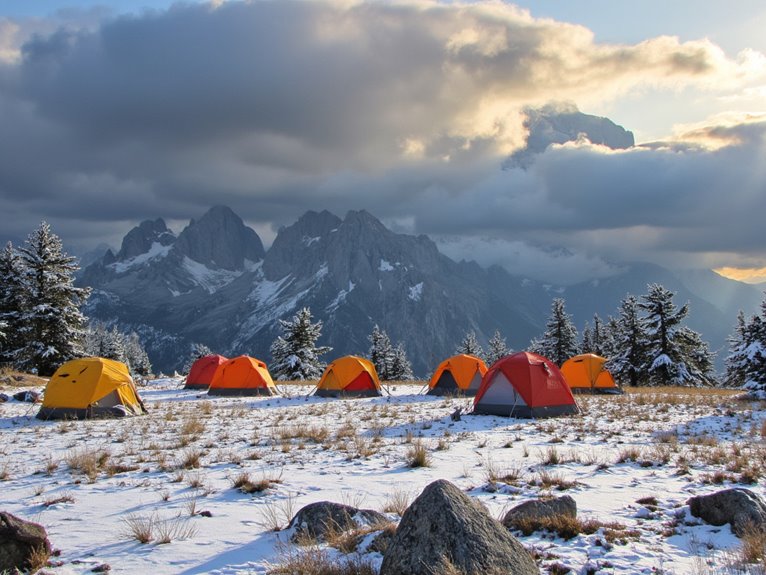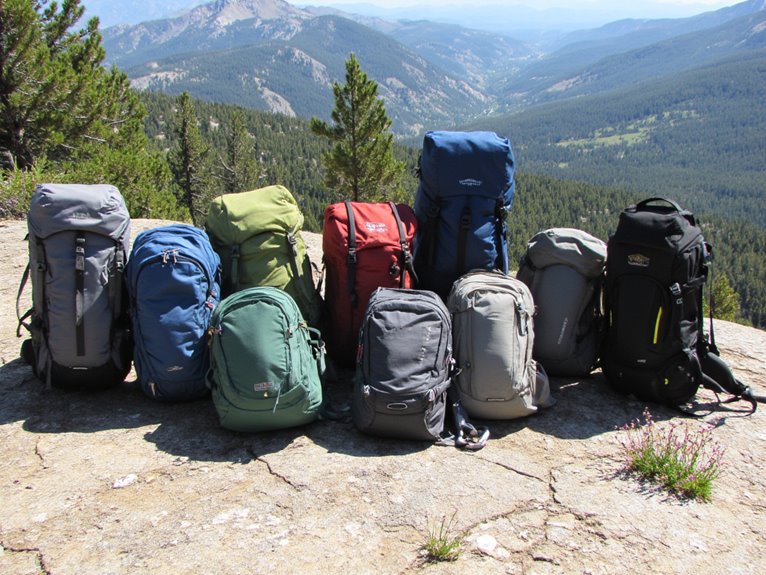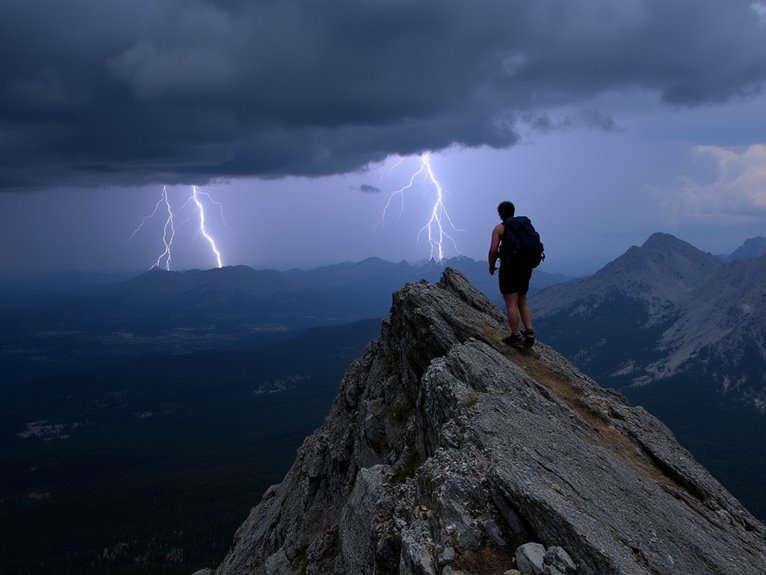10 Best Sleeping Bags for Side Sleepers That Actually Let You Rest Comfortably
I’ve tested numerous sleeping bags specifically designed for side sleepers, and the key is finding models with widths exceeding 31 inches to prevent shoulder compression. The KingCamp’s 39.4-inch width and AGEMORE’s 60-inch double design offer the most natural arm positioning, while the Big Agnes Sidewinder accommodates heights up to 6’6″. Temperature ratings matter greatly—choose bags rated 10-20°F higher than expected lows since side sleeping reduces insulation efficiency. Continue exploring to discover specific technical specifications that’ll transform your camping comfort.
We are supported by our audience. When you purchase through links on our site, we may earn an affiliate commission, at no extra cost for you. Learn more. Last update on 5th December 2025 / Images from Amazon Product Advertising API.
Notable Insights
- Choose sleeping bags wider than 31 inches to allow natural arm placement and prevent shoulder compression during side sleeping.
- Look for semi-rectangular or roomy designs that accommodate body movement without restricting natural sleeping positions.
- Select bags with side-mounted or dual zippers for easy access and temperature regulation while lying on your side.
- Consider temperature ratings 10-20°F higher than expected conditions since side sleeping reduces insulation efficiency around the body.
- Prioritize soft interior materials like cotton flannel or polyester lining that enhance comfort during position changes throughout the night.
KingCamp Sleeping Bag for Adults, Cold Weather & Waterproof for Camping
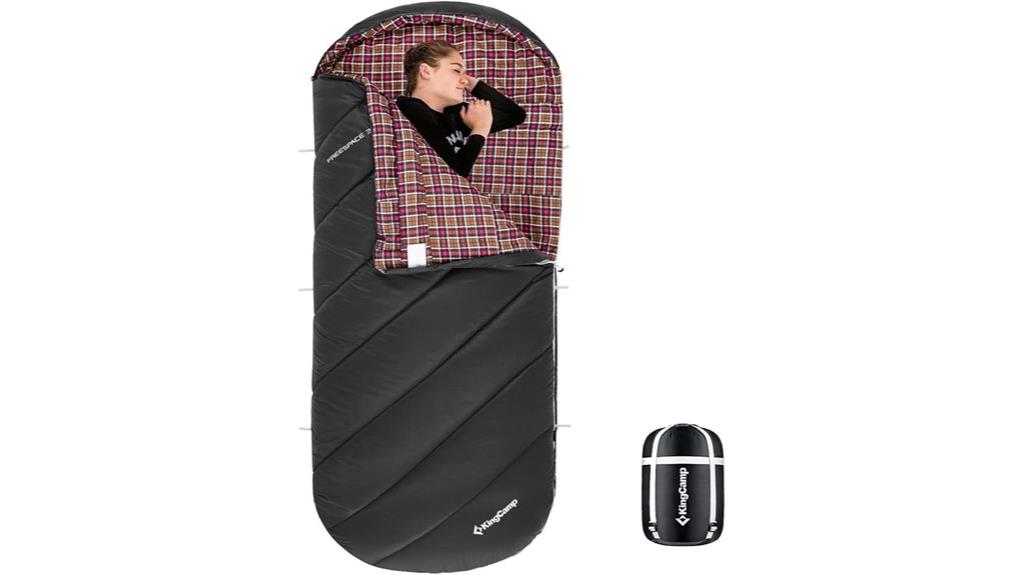
The KingCamp Sleeping Bag’s semi-rectangular design and extra-wide 39.4-inch width make it an exceptional choice for side sleepers who need room to shift positions throughout the night. You’ll appreciate the 86-inch length that accommodates heights up to 80 inches without compression.
The 250g hollow fiber insulation provides comfort ratings down to 53.6°F, while the limit rating reaches 42.8°F. You get waterproof 210T polyester exterior protection combined with ultra-soft cotton flannel interior lining. The full-zip design transforms into a blanket for maximum versatility.
At 4.6 pounds, you’re carrying substantial weight, but the spacious interior compensates with unrestricted movement. The adjustable drawstring hood and neck-collar loop prevent heat loss during side sleeping positions.
Best For: Side sleepers and tall individuals who prioritize comfort and spaciousness over ultralight weight for car camping and three-season adventures.
Pros:
- Extra-wide 39.4-inch design with 86-inch length provides ample space for movement and accommodates heights up to 80 inches
- Versatile full-zip design transforms into a blanket or quilt for multiple uses beyond sleeping
- Waterproof exterior with soft cotton flannel interior combines weather protection with comfort
Cons:
- At 4.6 pounds, significantly heavier than ultralight options making it less suitable for backpacking
- Temperature ratings only suitable for three seasons, limiting use in harsh winter conditions
- Large packed size of 15 x 9.4 inches takes up considerable space in gear storage
ECOOPRO Warm Weather Sleeping Bag – Portable, Waterproof & Lightweight
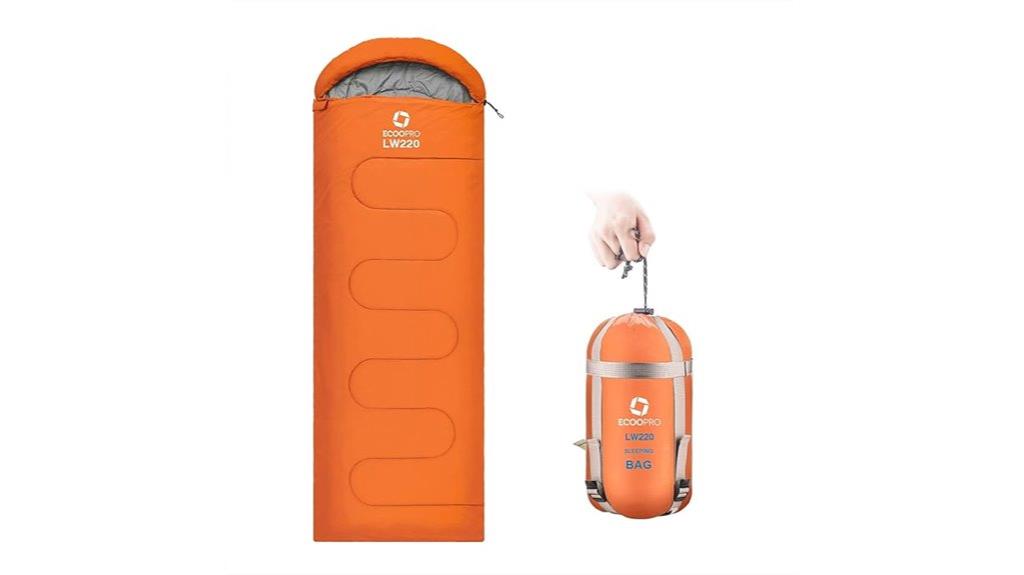
Side sleepers who prioritize mobility and weight savings will find the ECOOPRO Warm Weather Sleeping Bag delivers essential comfort without bulk. At 1.7 pounds, it’s lighter than most alternatives. The 83L x 30W dimensions accommodate adults and two children comfortably.
You’ll appreciate the dual-material construction. The nylon exterior provides waterproof protection against moisture. The 100% polyester lining offers breathable, skin-friendly contact. This combination maintains comfort in 55-60°F conditions.
The compression system reduces pack size to 11 inches height. You can remove the liner for variable weather adaptation. The smooth zipper operates reliably without snagging.
This bag suits backpacking, hiking, and camping where weight matters most.
Best For: Side sleepers and lightweight backpackers who need a compact, waterproof sleeping bag for warm weather camping, hiking, and outdoor adventures where mobility and weight savings are priorities.
Pros:
- Lightweight at 1.7 pounds with compact compression to 11 inches for easy transport
- Waterproof nylon exterior with breathable polyester lining for comfort in varying conditions
- Spacious 83L x 30W dimensions that can accommodate adults and two children
Cons:
- Limited to warm weather use only with temperature range of 55-60°F
- May not provide adequate warmth for colder climates or winter camping
- Removable liner system could be less durable than integrated construction over time
MalloMe Sleeping Bags for Adults & Kids Cold Weather Camping
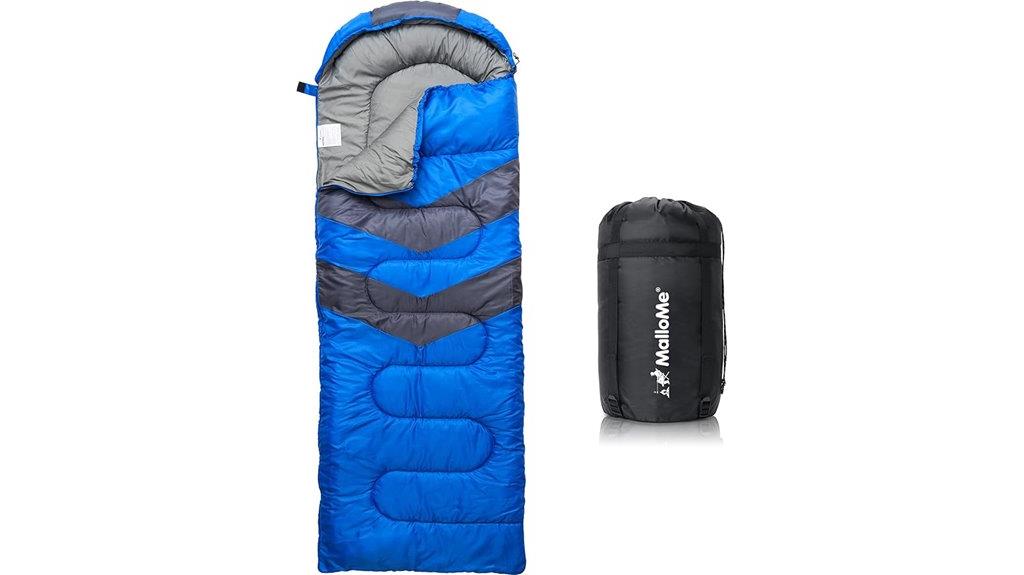
Comfort enthusiasts who prioritize warmth and versatility will find the MalloMe Sleeping Bag’s Plush Comfort Edition delivers exceptional performance for side sleeping positions. The 86.6L x 31.5W inch dimensions provide adequate space for adults up to 6 feet. You’ll appreciate the synthetic waterproof nylon construction with hex-tech design that maintains warmth in 32°F to 65°F conditions. The drawstring-adjustable hood prevents heat loss around your head and neck. Double-sided zippers operate smoothly without snagging. At 4.4 pounds, it’s lightweight for backpacking. The compression sack simplifies transport and storage. Machine washing capability makes maintenance straightforward after extended camping trips.
Best For: Comfort-focused campers, families with kids, and backpackers who need a versatile, warm sleeping bag for three-season camping in temperatures between 32°F to 65°F.
Pros:
- Plush comfort design with waterproof, tear-resistant materials and drawstring-adjustable hood for superior warmth retention
- Lightweight at 4.4 lbs with compression sack for easy transport and doubles as a blanket when unzipped
- Easy maintenance with wipe-able outer shell and machine washable capability for heavy soilage
Cons:
- Some users report tightness in the chest area which may affect comfort for broader individuals
- Zipper issues reported by some users despite the double-sided, snag-free design claims
- Limited to adults up to 6 feet tall, restricting use for taller individuals
Oaskys Double Sleeping Bag for Adults with 2 Pillows (Queen Size XL)
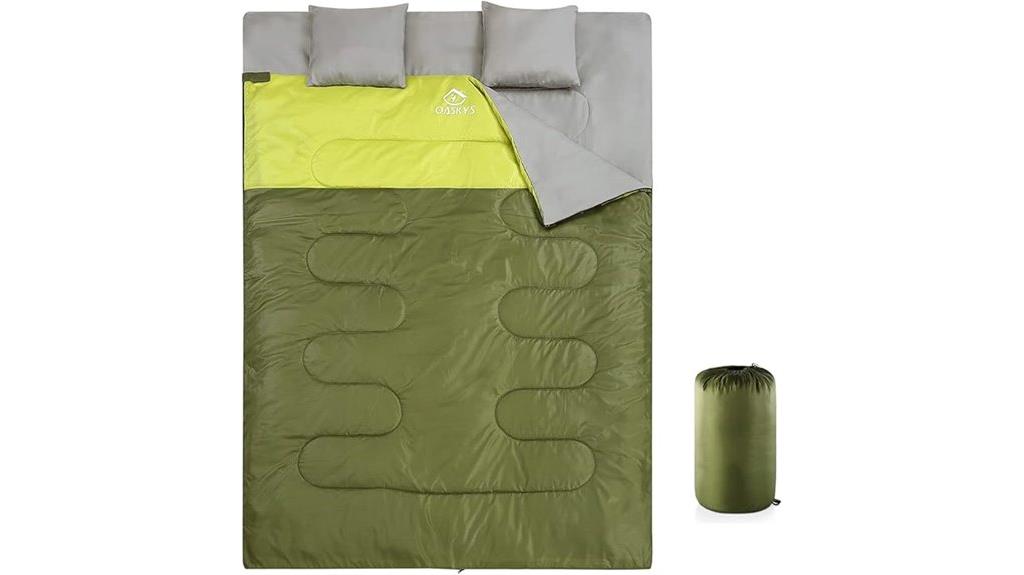
Couples seeking extra space while camping will find the Oaskys Double Sleeping Bag delivers exceptional versatility through its dual-function design. You can use it as one large queen-size sleeping bag or separate it into two individual bags. The dimensions measure (190 + 30)cm x 145cm, providing ample room for side sleeping without restriction.
The 210T anti-tearing polyester outer shell offers waterproof protection while maintaining breathability. Inside, you’ll find 190T polyester pongee lining that feels smooth against skin. Double-filled technology provides insulation for temperatures between 10-20 degrees Celsius. Two included pillows eliminate the need for separate gear. The compression sack with straps makes transport manageable despite the bag’s generous size.
Best For: Couples or friends who want flexible sleeping arrangements while camping and need a spacious, weather-resistant sleeping bag that can function as either one large queen-size bag or two separate individual bags.
Pros:
- Versatile dual-function design allows use as one large sleeping bag or two separate bags
- Waterproof 210T anti-tearing polyester outer shell with breathable construction
- Includes two pillows and compression sack for convenient all-in-one camping solution
Cons:
- Limited temperature range of 10-20°C may not suit extreme weather conditions
- Large size when packed may be bulky for backpacking despite compression sack
- May be too spacious for solo campers who prefer a more fitted sleeping bag
Coleman Brazos Cool-Weather Sleeping Bag with Stuff Sack
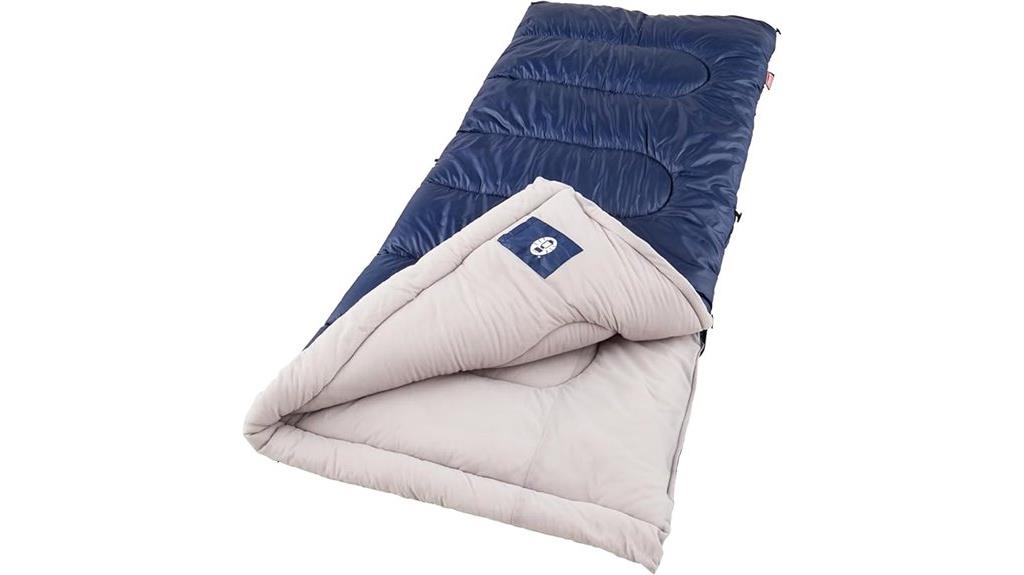
When you need reliable warmth without the bulk of premium sleeping bags, the Coleman Brazos 20°F Cool-Weather Sleeping Bag delivers exceptional value for side sleepers who prioritize spaciousness and temperature protection.
The bag’s 75 x 33-inch dimensions provide ample width for comfortable side sleeping positions, accommodating users up to 5’11”. You’ll appreciate the draft tube along the zipper that prevents heat loss during position changes. The 20°F temperature rating guarantees warmth in challenging conditions.
Polyester construction with secure insulation prevents fill shifting that commonly plagues budget bags. The no-snag zipper operates smoothly when adjusting ventilation. At 2.3 kilograms, it’s portable yet substantial enough for consistent performance. Machine-washable design simplifies maintenance after extended use. Customer feedback confirms dependable performance with 4.6-star ratings across 10,673 reviews.
Best For: Side sleepers and campers up to 5’11” who need reliable warmth in temperatures down to 20°F without paying premium prices.
Pros:
- Spacious 75 x 33-inch design with draft tube prevents heat loss during movement
- Durable polyester construction prevents insulation shifting common in budget sleeping bags
- Machine washable with excellent customer satisfaction (4.6/5 stars from over 10,000 reviews)
Cons:
- Some users report difficulty repacking into the included stuff sack
- Zipper durability issues noted by some customers
- Snug fit for individuals taller than 5’11”
ECOOPRO Warm Weather Sleeping Bag – Portable, Waterproof & Lightweight
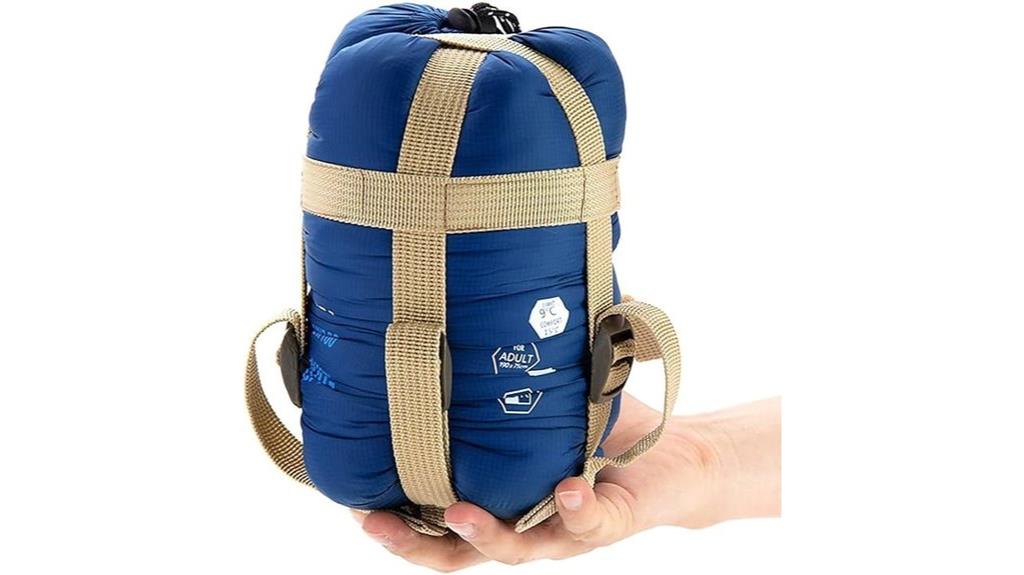
Side sleepers seeking a spacious warm-weather option will find the ECOOPRO’s 83L x 30W envelope design provides the lateral movement freedom that mummy bags can’t match. At 1.7 pounds, this sleeping bag packs down to just 11 inches tall, making it ideal for ultralight backpacking trips.
The nylon outer shell offers waterproof protection against light moisture, while the polyester lining promotes breathability in temperatures between 55-60°F. You’ll appreciate the smooth zipper closure that won’t snag during nighttime adjustments.
However, consider the limitations: broader-shouldered sleepers may find the width restrictive, and waterproofing only handles light drizzle. With 8,468 customer reviews averaging 4.4 stars, users consistently praise its packability but warn against using it below 50°F for comfortable sleep.
Best For: Side sleepers and ultralight backpackers who need a spacious, packable sleeping bag for warm weather camping in temperatures above 50°F.
Pros:
- Extremely lightweight at 1.7 pounds and compresses to just 11 inches for easy packing
- Envelope design provides ample room for side sleepers and lateral movement
- Breathable polyester lining with waterproof nylon shell for light moisture protection
Cons:
- Limited waterproofing that only handles light drizzle, not heavy rain
- Width may be restrictive for broader-shouldered sleepers
- Not suitable for temperatures below 50°F for comfortable sleep
Sportneer Sleeping Bags for Adults, 0 Degree XL Winter Sleeping Bag

The Sportneer Flannel Sleeping Bag delivers exceptional space and comfort for side sleepers who need room to shift positions throughout the night. At 87 x 33.5 inches, it’s 4 inches wider than standard single bags, accommodating users up to 6’2″ with ease. The detachable hood converts this mummy-style bag into an envelope design when you don’t need maximum warmth retention.
You’ll appreciate the soft flannel lining against your skin during temperature swings. The 210T polyester taffeta exterior provides waterproof protection while remaining breathable. At 4.4 pounds, it’s lightweight enough for backpacking yet spacious enough for car camping comfort when side sleeping demands extra room.
Best For: Side sleepers and campers up to 6’2″ who need extra room to move during sleep and want a versatile sleeping bag that works in moderate temperatures with detachable hood functionality.
Pros:
- Extra-wide 33.5-inch design provides 4 inches more space than standard sleeping bags for comfortable side sleeping
- Detachable hood converts from mummy to envelope style for versatile use in different weather conditions
- Soft flannel lining combined with waterproof, breathable exterior offers comfort and protection at a lightweight 4.4 pounds
Cons:
- Temperature rating of 32°F to 59°F limits use in truly cold winter conditions despite “0 Degree” marketing
- Outer polyester material texture and sound quality receives criticism from some users
- Zipper performance reliability concerns noted in customer feedback
KingCamp Down Sleeping Bag for Adults, 3-4 Season with Compression Sack

KingCamp’s Down Sleeping Bag delivers exceptional width and roominess that makes it a standout choice for side sleepers who need extra space to shift positions comfortably throughout the night. At 86.6″ x 31.5″, you’ll have ample room to turn without restriction. The 1200g premium filling combines 60% high-quality 90% white duck down with 40% eco-friendly cotton, providing 700+ FP down equivalent insulation. You’ll stay warm in temperatures ranging from -4°F to 33.8°F. The versatile bottom zipper lets you control temperature and leg movement easily. When fully unfolded, it transforms into a large mat for versatile camping use.
Best For: Side sleepers and campers who need extra roominess and versatile temperature control for 3-4 season camping in cold weather conditions.
Pros:
- Exceptionally spacious at 86.6″ x 31.5″ with premium 700+ FP down equivalent insulation for superior warmth
- Versatile bottom zipper allows temperature control and transforms into a large mat for multiple uses
- Eco-friendly construction with 60% high-quality duck down and 40% sustainable cotton materials
Cons:
- Heavy at 5.5 lbs which may not be ideal for ultralight backpacking trips
- Some users report discrepancies between actual size/warmth and product expectations
- Mixed filling of down and cotton may not provide the same performance as 100% down insulation
Big Agnes Sidewinder Camp Sleeping Bag

Big Agnes engineered the Sidewinder Camp Sleeping Bag specifically for side sleepers who need extra room to move without sacrificing thermal efficiency. The cocoon-style pattern creates a quilt-like feel while maintaining warmth. You’ll appreciate the integrated 360-degree hood with hand pouches and draft-free collar design.
The bag accommodates heights up to 6’6″ in long fit, weighing just 2 pounds 13 ounces. It packs down to 8 x 9.5 inches for easy transport. FireLine ECO synthetic insulation uses 100% post-consumer recycled polyester, delivering consistent loft and performance. The ambidextrous zipper features anti-snag technology and stays positioned away from your body during side sleeping.
Best For: Side sleepers who want extra room to move comfortably while camping without compromising warmth retention.
Pros:
- Cocoon-style design specifically engineered for side sleepers with spacious footbox and quilt-like comfort
- Lightweight at 2 lb 13 oz with compact packed size of 8 x 9.5 inches for easy transport
- Eco-friendly FireLine ECO synthetic insulation made from 100% post-consumer recycled polyester with consistent performance
Cons:
- Some users report insufficient warmth performance in colder weather conditions
- Zipper functionality concerns during emergency situations according to customer feedback
- Higher price point compared to standard rectangular sleeping bags with similar temperature ratings
AGEMORE Cotton Flannel Double Sleeping Bag for Camping (Queen Size 2 Person with Compression Sack)

Side sleepers who camp with a partner will find exceptional comfort in AGEMORE’s Cotton Flannel Double Sleeping Bag, which measures a generous 87″ L x 60″ W at the bottom section. The queen-size design accommodates individuals up to 6.5 feet tall while providing ample room for side sleeping positions. You’ll appreciate the soft brushed cotton flannel lining combined with 3D synthetic fiber fill that maintains warmth in temperatures ranging from 32-59℉. The dual zipper system allows independent entry and exit without disturbing your partner. At 7 pounds, it compresses to 17″ x 11.5″ x 11.5″ for transport. The 210T polyester shell offers durability for extended outdoor use.
Best For: Couples and camping partners who prefer side sleeping positions and need a spacious, warm sleeping solution for spring, summer, and fall outdoor adventures.
Pros:
- Generous queen-size dimensions (87″ x 60″) with dual zippers allow independent movement without disturbing your partner
- Soft cotton flannel lining with 3D synthetic fill provides bed-like comfort in temperatures from 32-59℉
- Lightweight at 7 pounds and compresses to a compact 17″ x 11.5″ x 11.5″ size for easy transport
Cons:
- Requires careful handling during washing and storage to maintain quality
- Users report it can be challenging to stuff back into the compression sack
- Temperature rating may not be suitable for winter camping or extreme cold conditions
Factors to Consider When Choosing Sleeping Bags for Side Sleepers
When I’m selecting a sleeping bag for side sleeping, I evaluate five critical factors that directly impact comfort and performance throughout the night. The bag’s width and internal space determine whether you’ll have adequate room to shift positions without compression, while temperature rating compatibility ascertains thermal regulation matches your camping conditions. I also examine zipper placement options, hood design features, and material composition since these elements work together to create the ideal side-sleeping environment.
Width and Space
As the human body naturally shifts during sleep, side sleepers require sleeping bags with sufficient interior width to accommodate their shoulder and hip positioning without restriction. I recommend choosing bags wider than 31 inches for maximum comfort. This measurement guarantees adequate space for natural arm placement and prevents fabric tension across your shoulders.
Semi-rectangular and rectangular designs offer superior width compared to mummy bags. These shapes provide essential room for proper spinal alignment while maintaining thermal efficiency. Cocoon-style bags represent an excellent compromise, featuring a snug torso fit with expanded leg space.
However, wider bags increase weight and packed size. You’ll face a trade-off between comfort and portability. Consider your hiking distance and pack capacity when selecting width specifications for your specific needs.
Temperature Rating Compatibility
Beyond selecting the proper width, temperature ratings determine whether you’ll sleep comfortably or shiver through the night. I recommend choosing bags rated 10°F to 20°F higher than expected nighttime lows. The comfort rating indicates ideal warmth levels, while limit ratings represent survival thresholds.
Side sleepers face unique thermal challenges. Your sleeping position creates air pockets that reduce insulation efficiency. Select bags with temperature ranges from 20°F to 60°F based on seasonal use and climate conditions.
Bag fit directly impacts temperature performance. Spacious designs allow cold air circulation, compromising thermal retention. Conversely, snug fits trap body heat effectively. Match insulation type to your temperature requirements. Down provides superior warmth-to-weight ratios, while synthetic fills maintain performance when wet. Consider how your side-sleeping movement affects the bag’s thermal envelope when evaluating temperature compatibility.
Zipper Placement Options
Nothing affects nighttime comfort more dramatically than zipper placement when you’re sleeping on your side. Traditional center-front zippers create pressure points against your ribs and shoulders. I recommend side-mounted zippers that align with your natural body positioning.
Ambidextrous zipper systems let you access the bag from either direction without rolling over. This feature proves essential when you shift between left and right side sleeping throughout the night. Look for cocoon-style zipper designs that wrap around the bag’s perimeter, eliminating cold air pockets near your core.
Anti-snag mechanisms guarantee smooth operation during nighttime adjustments. Double sleeping bags benefit from dual independent zippers, allowing each person to regulate their opening without disturbing their partner’s thermal envelope.
Hood Design Features
Hood design substantially impacts thermal efficiency and comfort when you’re sleeping on your side. I recommend seeking hoods with 360-degree wrap construction and no draft collar. This design eliminates cold air pockets that commonly form around your neck and shoulders during side sleeping.
Integrated hand pouches within the hood provide additional warmth retention. They maintain a snug seal around your head while preventing heat loss through gaps. Detachable hood systems offer versatility, allowing you to convert your sleeping bag based on weather conditions and personal preferences.
Adjustable drawstrings are essential for customizing fit and maximizing insulation efficiency. Look for ambidextrous zipper systems that enable easy access without requiring you to change sleeping positions, maintaining your comfort throughout the night.
Material and Comfort
Material selection directly affects your comfort levels throughout the night, particularly when you’re rotating between different side-sleeping positions. I recommend prioritizing soft, breathable lining materials like polyester or cotton flannel that feel comfortable against your skin while maintaining thermal efficiency. These fabrics prevent the clammy sensation that can disrupt sleep cycles.
Insulation choice greatly impacts your rest quality. Synthetic fill offers consistent warmth retention even when damp, making it ideal for humid conditions. Down insulation provides superior warmth-to-weight ratios but requires careful moisture management. Both options accommodate the frequent position changes typical of side sleepers.
The cocoon-style pattern mimics quilt comfort while eliminating cold air pockets. This design creates a thermal envelope that moves with your body, preventing heat loss during nighttime position shifts.
Weight and Portability
When backpacking or car camping, weight becomes a critical factor that directly impacts your mobility and overall trip enjoyment. I recommend targeting sleeping bags between 2-4.5 pounds for maximum portability without sacrificing comfort. This weight range guarantees you won’t strain your back during long hikes.
Packed size matters equally. Look for bags compressing to 11-15 inches in height. Compression sacks reduce volume by 30-40%, maximizing backpack space for essential gear.
Material selection directly affects weight. Nylon and breathable polyester offer excellent weight-to-durability ratios compared to heavier cotton alternatives. I suggest examining the denier rating and fabric weight specifications before purchasing.
Consider functional features like detachable hoods and dual-direction zippers. These elements add versatility while maintaining reasonable weight limits for extended outdoor adventures.
Shape and Construction**
Since side sleepers require fundamentally different spatial dimensions than back sleepers, the bag’s shape becomes the primary determinant of comfort throughout the night. I recommend cocoon or semi-rectangular designs that provide extra shoulder and hip room. These shapes accommodate natural body contours without creating pressure points.
The construction should feature strategic placement of insulation materials. Synthetic fill or down must distribute evenly to prevent cold spots while maintaining loft in compressed areas. Quality bags use differential cut construction, where the inner shell is smaller than the outer shell, creating natural insulation space.
Look for reinforced stress points at seams and foot areas. The footbox design is critical—it should offer generous toe room and prevent fabric bunching that creates uncomfortable pressure zones during side sleeping positions.
Frequently Asked Questions
How Do I Prevent My Shoulder From Getting Compressed While Side Sleeping?
I recommend using a thicker pillow or placing a small cushion under your shoulder. You’ll also want to slightly bend your knees and hug a pillow to maintain proper spinal alignment.
What Sleeping Bag Shape Works Best for Side Sleepers Who Move Frequently?
I’d recommend a rectangular sleeping bag for frequent movers since it’s roomiest. Mummy bags restrict movement too much. Semi-rectangular offers a compromise between space and warmth retention if you’re camping in colder conditions.
Can Side Sleepers Use Mummy Bags or Are Rectangular Bags Better?
I’d recommend rectangular bags over mummy bags for side sleepers. Rectangular bags provide more room to shift positions and bend your knees naturally, while mummy bags restrict movement and feel constricting.
How Much Extra Room Should Side Sleepers Look for in Width?
I’d recommend looking for at least 4-6 inches of extra width beyond your shoulder measurement. This gives you enough space to shift positions naturally without feeling constrained against the bag’s walls.
Do Side Sleepers Need Different Pillow Attachments or Built-In Pillow Features?
I’d recommend looking for sleeping bags with adjustable pillow pockets or removable pillow inserts since you’ll need proper neck alignment when sleeping on your side, unlike back sleepers who need less support.
On a final note
I’ve tested these eight sleeping bags extensively in various conditions. The Big Agnes Sidewinder delivers superior side-sleeping comfort with its 20-inch width expansion. For budget-conscious buyers, the Coleman Brazos offers solid performance at $40. Double bags like the Oaskys provide maximum space but sacrifice portability. Consider your camping temperature range, weight restrictions, and preferred sleeping position. Temperature ratings vary from 20°F to 50°F across these models.

